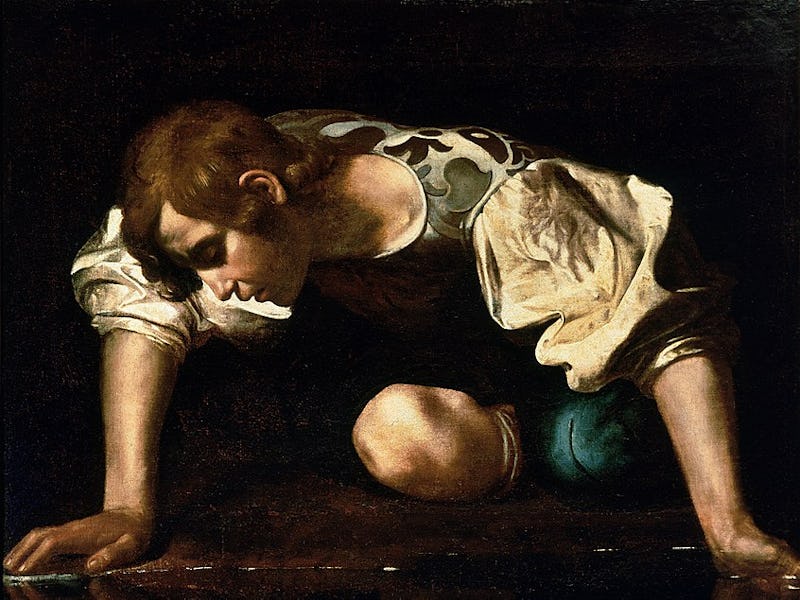How to spot a narcissist, even non-traditional ones

Chances are you’ve met a narcissist. Someone who thinks they’re better than everyone else dominates the conversation and loves the limelight. But scientists are increasingly realizing that not all narcissists are the same — some are, in fact, extremely insecure.
In our new paper, published in the Personality and Social Psychology Bulletin, we describe the distinct types — and what motivates them.
In classical Greek mythology, the hunter Narcissus was the son of the river god Cephissus and the nymph Liriope. He was known for his exceptional beauty and physique. One day when Narcissus was walking in the forest, the beautiful nymph Echo saw him and fell in love with him. However, he rejected her affections, leaving her heartbroken.
As a punishment, Nemesis, the goddess of revenge, lured him to a pool of water where he encountered his own reflection for the first time. Narcissus fell in love with his reflection, and, eventually realizing that his love could not be reciprocated, pined away to his death.
The myth of Narcissus warns us of the dangers of excessive self-love, self-absorption, and lack of empathy for others. It has had a profound influence on western culture, art, and literature.
Narcissism is also a popular topic in psychology. The English physician Havelock Ellis first identified narcissism as a mental disorder in the late 19th century. Sigmund Freud considered narcissism to be a normal part of a child’s development but argued that it could become a disorder if it persisted after puberty into adulthood.
In modern psychology, narcissism is usually conceptualized as a personality trait, which lies on a spectrum. Some people are more narcissistic, others less so. Narcissism typically involves an inflated view of oneself, a sense of superiority and entitlement, and a lack of concern for others. The above portrait of a narcissist is a familiar one. But it isn’t the only one.
Grandiose versus vulnerable narcissism
In our research, we investigated two types of previously identified narcissism: grandiose and vulnerable. Grandiose narcissists are arrogant, dominant, and extroverted. They tend to have high self-esteem, be bold and assertive, and feel happy and confident about their lives.
Vulnerable narcissists, on the other hand, are withdrawn, neurotic, and insecure. They tend to have low self-esteem, be hypersensitive, and feel anxious and depressed. However, these two types of narcissists also have something in common. Both are selfish, feel entitled to special treatment and privileges, and relate to others in antagonistic ways.
You might be able to recognize the two types of narcissists by how they behave in social situations:
- Grandiose narcissists are socially competent. They are likely to be dominant and charming.
- Vulnerable narcissists, on the other hand, are less socially skilled. They are likely to be shy and anxious in social situations.
- What’s more, while grandiose narcissists are forthright and assertive in pursuing their goals, seeking to maximize success, vulnerable narcissists are timid and defensive, seeking to minimize failure.
In our research, we examined the social motives and perceptions of both grandiose and vulnerable narcissists. In particular, we investigated their desires to attain social status and social inclusion. We also looked at whether they felt they had been successful in attaining social status and social inclusion.
Social status refers to being respected and admired by others. It involves standing out and being seen as an important person in the social hierarchy. In contrast, social inclusion refers to being liked and accepted by others. It involves fitting in well with others as part of the social community.
Any given person may have or desire both status and inclusion, only one of the two, or neither. For example, in the TV show The Simpsons, the character of Mr. Burns has high status but is not particularly liked and accepted, whereas the character of Homer Simpson is well-liked and accepted but does not have high status.
Grandiose narcissists are arrogant, dominant and extroverted
We conducted two studies, recruiting 676 adults based in the United States. We assessed their levels of both grandiose and vulnerable narcissism. We also assessed the extent to which they desired status and inclusion as well as the extent to which they felt they had attained their goals.
We found that both grandiose and vulnerable narcissists strongly desired social status. Interestingly, whereas grandiose narcissists felt they were successful in attaining this status, vulnerable narcissists felt they did not get the status they deserved.
What’s more, grandiose narcissists did not feel they had attained social inclusion but did not particularly desire it either. In contrast, vulnerable narcissists also did not feel they had attained social inclusion but strongly desired it. Grandiose narcissists, therefore, felt they had met their social goals, but vulnerable narcissists did not.
Both types of narcissists crave the respect and admiration of others. But while grandiose narcissists may be stars on the interpersonal stage, triumphantly capturing the spotlight, their vulnerable counterparts may be a bit player lurking on the sidelines, resentfully seeking, but failing to obtain, the applause they crave.
This article was originally published on The Conversation by Nikhila Mahadevan at the University of Essex. Read the original article here.